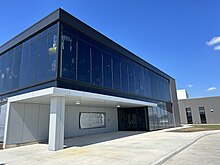Loading AI tools
American aerospace company From Wikipedia, the free encyclopedia
Intuitive Machines, Inc. is an American space exploration company headquartered in Houston, Texas. It was founded in 2013 by Stephen Altemus,[1] Kam Ghaffarian, and Tim Crain, to provide lunar surface access, lunar orbit delivery, and communication from lunar distance.[2] Intuitive Machines holds three NASA contracts under the space agency's Commercial Lunar Payload Services (CLPS) programme,[3] to deliver payloads to the lunar surface.[4] Among these, the company holds a contract to develop a Lunar Terrain Vehicle (LTV).[5]
 | |
 Lunar Operations Facility at Houston Spaceport | |
| Company type | Public |
|---|---|
| Nasdaq: LUNR | |
| Industry | Aerospace |
| Founded | 2013 |
| Founders |
|
| Headquarters | , U.S. |
Key people | Steve Altemus (president and CEO) |
| Products | Lunar lander, Mission Control Center, Ground stations, additive manufacturing |
Number of employees | 250+ (as of 27 October 2023[update]) (135-150, in 2022) |
| Website | www |
The privately held Intuitive Machines, LLC,[6] became a public company after merging with a special-purpose acquisition company, Inflection Point Acquisition Corp., in February 2023. The company is listed on the Nasdaq, incorporated in Delaware.[7] On February 22, 2024, the Odysseus IM-1 spacecraft landed on the Moon. It was the first privately built craft to land on the Moon, and the first American spacecraft to do so since 1972.[8][9][10][11] The Odysseus lander fell on its side when landing, but its instruments remained partially functional (albeit with a reduced downlink capacity),[12] so the mission was judged successful.[13]
Intuitive Machines (IM) has designed airborne drones and spacecraft, including the Universal Reentry Vehicle (URV),[14] the Nova-C lunar lander,[15] and other flight instrument systems.

In November 2018, IM was selected by NASA as one of nine companies to bid on the Commercial Lunar Payload Services program (CLPS).[16] Their lander, Nova-C, was NASA CLPS first mission of the program, focused on the exploration and use of natural resources of the Moon.[17]
On 31 May 2019, NASA announced it had awarded Intuitive Machines $77 million to build and launch their Nova-C Moon lander.[18][19][20]
On 13 April 2020, IM, under contract to carry NASA science instruments to the Moon on a robotic spacecraft, said that its first lunar mission would target a deep, narrow valley named Vallis Schröteri.
By April 2021, the landing site had been changed to an unspecified location between Mare Serenitatis and Mare Crisium.[21]
Intuitive Machines announced in October 2019 that its first Nova-C lander would launch on a SpaceX Falcon 9 rocket. The company said on 15 April 2020 that the lunar mission, designated IM-1, would launch as soon as 11 October 2021 from pad LC-39A at Kennedy Space Center in Florida.[22] IM had previously reported the first Nova-C lander was scheduled for launch in July 2021. Josh Marshall, a company spokesperson, said on 15 April 2020, that the mission had been pushed back three months due to impacts from a protest of the company's contract, by Deep Space Systems. Deep Space Systems also bid for the contracts that were ultimately won by Intuitive Machines and Astrobotic Technology. After a review, the Government Accountability Office (GAO) upheld NASA's selection of Intuitive Machines and Astrobotic Technology, allowing work on the CLPS missions to proceed.[22] As of May 2022[update], IM-1 was scheduled to launch on 22 December 2022,[23] but in November 2022, IM-1 was rescheduled for March 2023 earliest.
In February 2024, the company launched its first mission, with the Nova-C spending six days travelling to the moon before orbiting and descending to the surface to make the first landing by the US in more than 50 years since Apollo 17 touched down in 1972.[24][25]
The Intuitive Machines contract with NASA covered transportation and operations at the Moon for five NASA science instruments.
Following the launch of IM-1, Intuitive Machines' stock surged 35% in one trading day, rising 75% total by Friday, February 16.[26]
Intuitive Machines’ stock sank 32% after the Odysseus moon lander fell on its side on 23 February 2024.
IM-2 is planned to launch in January of 2025.[27]
In April 2023, Space Networks Solution,[28] a joint venture of Intuitive Machines and KBR was awarded a five year contract worth up to $719 million to support NASA's Joint Polar Satellite System.[29]
In September 2022, Intuitive Machines announced that it would merge into special-purpose acquisition company (SPAC) Inflection Point Acquisition Corp. (IPAX) and incorporate as a publicly held company. The transaction was approved by IPAX's shareholders on February 8, 2023 and the business combination was completed six days later.[30][31]
The stock of the newly named Intuitive Machines, Inc., began trading on the Nasdaq exchange on 14 February 2023.[32][33]
Project Morpheus was a NASA project that in 2010 began to develop a landing test vehicle similar to the IM Nova-C. Tim Crain had worked on the project and later became the CTO of Intuitive Machines. In an interview with NASA recorded in October 2023, Crain mentioned the possible development of a Nova-D lander.[34][35]
Seamless Wikipedia browsing. On steroids.
Every time you click a link to Wikipedia, Wiktionary or Wikiquote in your browser's search results, it will show the modern Wikiwand interface.
Wikiwand extension is a five stars, simple, with minimum permission required to keep your browsing private, safe and transparent.